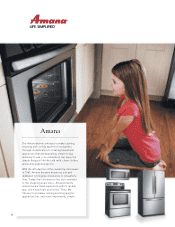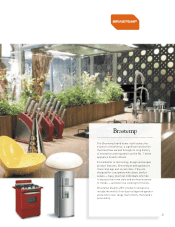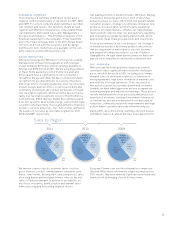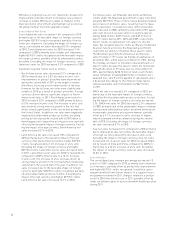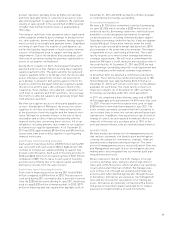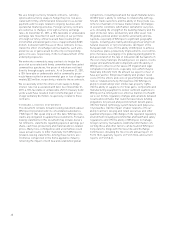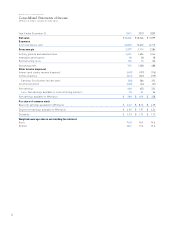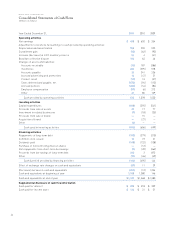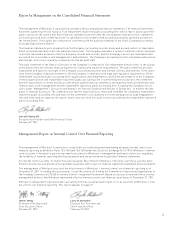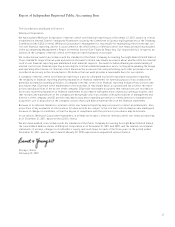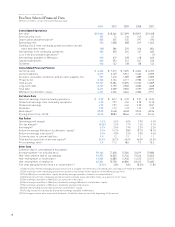Whirlpool 2011 Annual Report Download - page 41
Download and view the complete annual report
Please find page 41 of the 2011 Whirlpool annual report below. You can navigate through the pages in the report by either clicking on the pages listed below, or by using the keyword search tool below to find specific information within the annual report.39
product transition, partially offset by higher net earnings
and more favorable terms of collection of accounts receiv-
able and of payment to suppliers. In addition, the significant
slowing of sales growth in the second half of 2010 resulted
in higher than normal inventory levels of approximately
three days.
The timing of cash flows from operations varies significantly
within a quarter primarily due to changes in production lev-
els, sales patterns, promotional programs, funding require-
ments as well as receivable and payment terms. Dependent
on timing of cash flows, the location of cash balances, as
well as the liquidity requirements of each country, external
sources of funding are used to support working capital
requirements. Due to the variables discussed above, cash
flow used in operations during the year was significantly in
excess of our quarter-end balances.
During the first quarter of 2011, the European Parliament
approved a directive that changes existing laws regarding
supplier payment terms. The approved directive generally
requires payment terms to be 30 days from the invoice date
unless otherwise stated in the contract. An extension of
up to 60 days is allowed if both parties agree to the terms.
Countries within the European Union are required to adopt
this directive within 2 years. We continue to monitor this
situation as these changes, once adopted, could affect our
cash flows to suppliers and from customers, since our pay-
ment terms to affected suppliers are generally longer than
from affected customers.
We offer our suppliers access to third-party payables pro-
cessors. Independent of Whirlpool, the processors allow
suppliers to sell their receivables to financial institutions
at the discretion of only the supplier and the financial insti-
tution. We have no economic interest in the sale of these
receivables and no direct financial relationship with the
financial institutions concerning these services. All of our
obligations, including amounts due, remain to our suppliers
as stated in our supplier agreements. As of December 31,
2011 and 2010, approximately $952 million and $916 million,
respectively, have been sold by suppliers to participating
financial institutions.
Cash Flows from Investing Activities
Cash used in investing activities of $596 million during 2011
was consistent with cash used in 2010 of $606 million. We
continue to increase our capital spending to support new
products and innovation. Cash used in investing activities in
2010 was $606 million, an increased outflow of $107 million
compared to 2009. The increase in cash used in investing
activities was primarily due to increased capital spending
and lower proceeds from the sale of assets.
Cash Flows from Financing Activities
Cash used in financing activities during 2011 totaled $166
million compared to $495 million in 2010. The decrease in
cash used during 2011 is primarily due to proceeds received
from the $300 million bond offering in June 2011, which was
used to repay $300 million of maturing debt. In 2010, $379
million of maturing debt was repaid from available cash. At
December 31, 2011 and 2010, we had no commercial paper
or credit facility borrowings outstanding.
Financing Arrangements
We have a $1.725 billion committed credit facility maturing
on June 28, 2016 which includes a $200 million letter of
credit sub-facility. Borrowings under the credit facility are
available to us and designated subsidiaries for general
corporate purposes, including commercial paper support.
Subsidiary borrowings under this facility, if any, are guaran-
teed by Whirlpool Corporation. Interest under the credit
facility accrues at a variable annual rate based on LIBOR
plus a margin or the prime rate plus a margin. The margin
is dependent on our credit rating at that time. The credit
facility requires us to meet certain leverage and interest
coverage requirements. We will incur a commitment fee
based on Whirlpool’s credit rating for any unused portion of
the credit facility. At December 31, 2011 and 2010, we had
no borrowings outstanding under this credit agreement and
are in compliance with financial covenant requirements.
In December 2011, we obtained a committed credit facility
in Brazil. The credit facility provides borrowings up to 700
million Brazilian reais (approximately $373 million as of
December 31, 2011), with certain restrictions on the amount
available for each draw. The credit facility contains no
financial covenants. As of December 31, 2011, we had no
borrowings outstanding under this credit agreement.
In 2011, we completed a debt offering comprised of $300
million aggregate principal amount of 4.85% notes due June
15, 2021. Proceeds from the issuance were used to repay
$300 million in term debt that matured in June 2011. The
notes contain customary covenants that limit our ability to
incur certain liens or enter into certain sale and lease-back
transactions. In addition, if we experience a specific kind of
change of control, we are required to make an offer to pur-
chase all of the notes at a purchase price of 101% of the
principal amount thereof, plus accrued and unpaid interest.
MARKET RISK
We have in place an enterprise risk management process
that involves systematic risk identification and mitigation
covering the categories of enterprise, strategic, financial,
operation and compliance and reporting risk. The enter-
prise risk management process receives Board of Directors
and Management oversight, drives risk mitigation decision-
making and is fully integrated into our internal audit plan-
ning and execution cycle.
We are exposed to market risk from changes in foreign
currency exchange rates, domestic and foreign interest
rates, and commodity prices, which can affect our operating
results and overall financial condition. We manage expo-
sure to these risks through our operating and financing
activities and, when deemed appropriate, through the use
of derivatives. Derivatives are viewed as risk management
tools and are not used for speculation or for trading pur-
poses. Derivatives are generally contracted with a diversi-
fied group of investment grade counterparties to reduce
exposure to nonperformance on such instruments.



